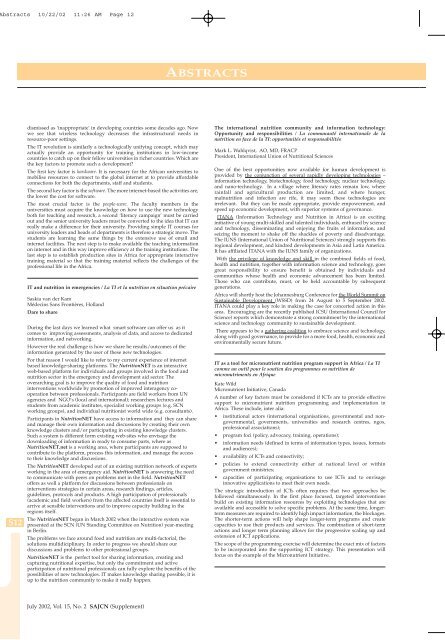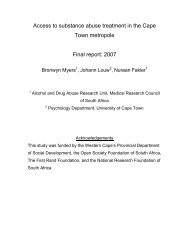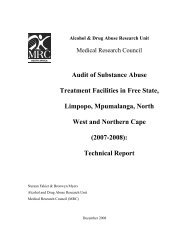Pan-African Conference 21 - 24 July 2002 Inter-Continental Hotel ...
Pan-African Conference 21 - 24 July 2002 Inter-Continental Hotel ...
Pan-African Conference 21 - 24 July 2002 Inter-Continental Hotel ...
Create successful ePaper yourself
Turn your PDF publications into a flip-book with our unique Google optimized e-Paper software.
Abstracts 10/22/02 11:26 AM Page 12<br />
S12<br />
dismissed as ‘inappropriate’ in developing countries some decades ago. Now<br />
we see that wireless technology decreases the infrastructural needs in<br />
resource-poor settings.<br />
The IT revolution is similarly a technologically unifying concept, which may<br />
actually provide an opportunity for training institutions in low-income<br />
countries to catch up on their fellow universities in richer countries. Which are<br />
the key factors to promote such a development?<br />
The first key factor is hardware. It is necessary for the <strong>African</strong> universities to<br />
mobilise resources to connect to the global internet at to provide affordable<br />
connections for both the departments, staff and students.<br />
The second key factor is the software. The more internet-based the activities are,<br />
the lower the cost for software.<br />
The most crucial factor is the people-ware. The faculty members in the<br />
universities must acquire the knowledge on how to use the new technology<br />
both for teaching and research, a second ‘literacy campaign’ must be carried<br />
out and the senior university leaders must be converted to the idea that IT can<br />
really make a difference for their university. Providing simple IT courses for<br />
university leaders and heads of departments is therefore a strategic move. The<br />
students are learning the same things by the extensive use of email and<br />
internet facilities. The next step is to make available the teaching information<br />
on internet and in this way improve efficiency at the training institutions. The<br />
last step is to establish production sites in Africa for appropriate interactive<br />
training material so that the training material reflects the challenges of the<br />
professional life in the Africa.<br />
IT and nutrition in emergencies / La TI et la nutrition en situation précaire<br />
Saskia van der Kam<br />
Médecins Sans Frontières, Holland<br />
Dare to share<br />
During the last days we learned what smart software can offer us as it<br />
comes to improving assessments, analysis of data, and access to dedicated<br />
information, and networking.<br />
However the real challenge is how we share he results/outcomes of the<br />
information generated by the user of these new technologies.<br />
For that reason I would like to refer to my current experience of internet<br />
based knowledge-sharing platforms. The NutritionNET is an interactive<br />
web-based platform for individuals and groups involved in the food and<br />
nutrition sector in the emergency and development aid sector. The<br />
overarching goal is to improve the quality of food and nutrition<br />
interventions worldwide by promotion of improved interagency cooperation<br />
between professionals. Participants are field workers from UN<br />
agencies and NGO’s (local and international); researchers lectures and<br />
students from academic institutes, specialist working groups (e.g. SCN<br />
working groups), and individual nutritionist world wide (e.g. consultants).<br />
Participants in NutritionNET have access to information and they can share<br />
and manage their own information and discussions by creating their own<br />
knowledge clusters and/or participating in existing knowledge clusters.<br />
Such a system is different form existing web-sites who envisage the<br />
downloading of information in ready to consume parts, where as<br />
NutritionNET.net is a working area, where participants are supposed to<br />
contribute to the platform, process this information, and manage the access<br />
to their knowledge and discussions.<br />
The NutritionNET developed out of an existing nutrition network of experts<br />
working in the area of emergency aid. NutritionNET is answering the need<br />
to communicate with peers on problems met in the field. NutritionNET<br />
offers as well a platform for discussions between professionals on<br />
interventions strategies in certain areas, research findings, articles,<br />
guidelines, protocols and products. A high participation of professionals<br />
(academic and field workers) from the affected countries itself is essential to<br />
arrive at sensible interventions and to improve capacity building in the<br />
regions itself.<br />
The NutritionNET began in March <strong>2002</strong> when the interactive system was<br />
presented at the SCN (UN Standing Committee on Nutrition) year-meeting<br />
in Berlin.<br />
The problems we face around food and nutrition are multi-factorial, the<br />
solutions multidiciplinary. In order to progress we should share our<br />
discussions and problems to other professional groups.<br />
NutritionNET is the perfect tool for sharing information, creating and<br />
capturing nutritional expertise, but only the commitment and active<br />
participation of nutritional professionals can fully explore the benefits of the<br />
possibilities of new technologies. IT makes knowledge sharing possible, it is<br />
up to the nutrition community to make it really happen.<br />
<strong>July</strong> <strong>2002</strong>, Vol. 15, No. 2 SAJCN (Supplement)<br />
ABSTRACTS<br />
The international nutrition community and information technology:<br />
Opportunity and responsibilities / La communauté internationale de la<br />
nutrition en face de la TI: opportunités et responsabilités<br />
Mark L. Wahlqvist, AO, MD, FRACP<br />
President, <strong>Inter</strong>national Union of Nutritional Sciences<br />
One of the best opportunities now available for human development is<br />
provided by the conjunction of several rapidly developing technologies –<br />
information technology, biotechnology, food technology, nuclear technology,<br />
and nano-technology. In a village where literacy rates remain low, where<br />
rainfall and agricultural production are limited, and where hunger,<br />
malnutrition and infection are rife, it may seem these technologies are<br />
irrelevant. But they can be made appropriate, provide empowerment, and<br />
speed up economic development, with superior systems of governance.<br />
ITANA (Information Technology and Nutrition in Africa) is an exciting<br />
initiative of young multi-skilled and talented individuals, enthused by science<br />
and technology, disseminating and enjoying the fruits of information, and<br />
seizing the moment to shake off the shackles of poverty and disadvantage.<br />
The IUNS (<strong>Inter</strong>national Union of Nutritional Sciences) strongly supports this<br />
regional development, and kindred developments in Asia and Latin America.<br />
It has affiliated ITANA with the IUNS family of organizations.<br />
With the privilege of knowledge and skill in the combined fields of food,<br />
health and nutrition, together with information science and technology, goes<br />
great responsibility to ensure benefit is obtained by individuals and<br />
communities whose health and economic advancement has been limited.<br />
Those who can contribute, must, or be held accountable by subsequent<br />
generations.<br />
Africa will shortly host the Johannesburg <strong>Conference</strong> for the World Summit on<br />
Sustainable Development (WSSD) from <strong>24</strong> August to 5 September <strong>2002</strong>.<br />
ITANA could play a key role in making the case for concerted action in this<br />
area. Encouraging are the recently published ICSU (<strong>Inter</strong>national Council for<br />
Science) reports which demonstrate a strong commitment by the international<br />
science and technology community to sustainable development.<br />
There appears to be a gathering coalition to embrace science and technology,<br />
along with good governance, to provide for a more food, health, economic and<br />
environmentally secure future.<br />
IT as a tool for micronutrient nutrition program support in Africa / La TI<br />
comme un outil pour le soutien des programmes en nutrition de<br />
micronutriments en Afrique<br />
Kate Wild<br />
Micronutrient Initiative, Canada<br />
A number of key factors must be considered if ICTs are to provide effective<br />
support to micronutrient nutrition programming and implementation in<br />
Africa. These include, inter alia:<br />
• institutional actors (international organisations, governmental and nongovernmental,<br />
governments, universities and research centres, ngos,<br />
professional associations);<br />
• program foci (policy, advocacy, training, operations);<br />
• information needs (defined in terms of information types, issues, formats<br />
and audiences);<br />
• availability of ICTs and connectivity;<br />
• policies to extend connectivity either at national level or within<br />
government ministries;<br />
• capacities of participating organisations to use ICTs and to envisage<br />
innovative applications to meet their own needs.<br />
The strategic introduction of ICTs often requires that two approaches be<br />
followed simultaneously. In the first place focused, targeted interventions<br />
build on existing information resources by exploiting technologies that are<br />
available and accessible to solve specific problems. At the same time, longerterm<br />
measures are required to identify high impact information, the blockages.<br />
The shorter-term actions will help shape longer-term programs and create<br />
capacities to use their products and services. The combination of short-term<br />
actions and longer term planning allows for the progressive scaling up and<br />
extension of ICT applications.<br />
The scope of the programming exercise will determine the exact mix of factors<br />
to be incorporated into the supporting ICT strategy. This presentation will<br />
focus on the example of the Micronutrient Initiative.

















